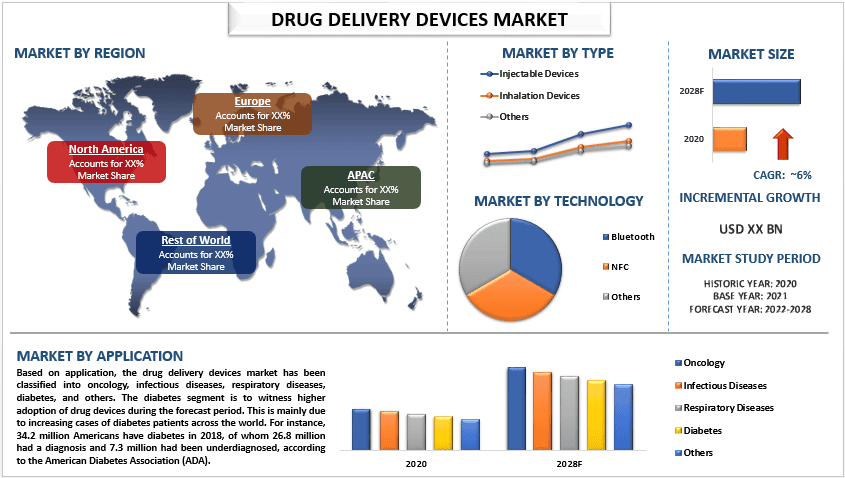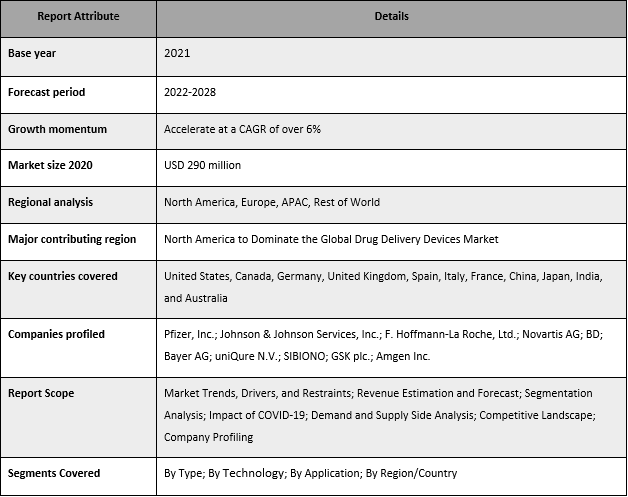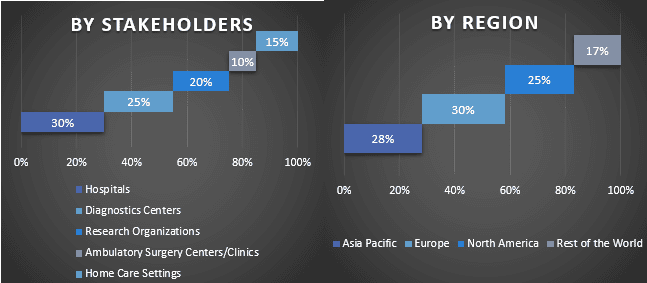- Inicio
- Acerca de nosotros
- Industria
- Servicios
- Leyendo
- Contáctenos
Mercado de dispositivos de administración de fármacos: Análisis actual y previsión (2022-2028)
Énfasis en el tipo (dispositivos inyectables, dispositivos de inhalación y otros); tecnología (Bluetooth, NFC y otros); aplicación (oncología, enfermedades infecciosas, enfermedades respiratorias, diabetes y otros); y región/país

Se espera que el Mercado Global de Dispositivos de Administración de Fármacos crezca a una tasa significativa de alrededor del 6% durante el período de pronóstico. Los dispositivos de administración de fármacos son herramientas especializadas hechas para una ruta específica de administración de fármacos o material terapéutico. Los dispositivos se utilizan una o más veces durante los procedimientos médicos. Los dispositivos de administración de fármacos presentan desafíos únicos en muchas áreas del desarrollo de productos, como la estrategia regulatoria, el diseño y las consideraciones de materiales, así como la creación y el uso de protocolos de prueba. El crecimiento en el número de pacientes diabéticos, así como un aumento en la prevalencia de cáncer y enfermedades respiratorias, están impulsando un aumento en el uso de sistemas de administración de fármacos entre pacientes y profesionales. Los avances tecnológicos en la fabricación de dispositivos médicos han llevado al desarrollo de dispositivos innovadores de administración de fármacos que garantizan que se administre la cantidad correcta de medicamento al paciente en el momento adecuado. Además, la creciente carga de enfermedades crónicas como la diabetes, las enfermedades cardiovasculares, el cáncer y la EPOC está impulsando la necesidad de dispositivos de administración de fármacos. Por ejemplo, según la Agencia Internacional para la Investigación del Cáncer, en 2020, se informaron aproximadamente 19,3 millones de nuevos casos de cáncer y 10 millones de muertes por cáncer en todo el mundo. Se estima que los casos de cáncer en todo el mundo aumentarán en un 47% entre 2020 y 2040. Se espera que se registren 28,4 millones de casos para 2040 en todo el mundo. Además, las enfermedades cardiovasculares representaron alrededor del 32% de las muertes a nivel mundial en 2019. El rápido desarrollo de biofarmacéuticos y el desarrollo de muchos fármacos capaces de curar eficazmente las enfermedades crónicas ha impulsado la demanda de dispositivos de administración de fármacos en todo el mundo.
Pfizer, Inc.; Johnson & Johnson Services, Inc.; F. Hoffmann-La Roche, Ltd.; Novartis AG; BD; Bayer AG; uniQure N.V.; SIBIONO; GSK plc.; Amgen Inc. son algunos de los actores clave en el mercado. Estos actores han emprendido varias fusiones y adquisiciones junto con asociaciones para facilitar a los clientes productos/tecnologías innovadores y de alta tecnología.
Perspectivas Presentadas en el Informe
"Entre los tipos, el segmento de dispositivos inyectables será testigo de una CAGR más alta durante el período de pronóstico"
Según el tipo, el mercado se segmenta en dispositivos inyectables, dispositivos de inhalación y otros. El segmento inyectable fue testigo de una CAGR más alta durante el período de pronóstico debido a la creciente demanda de sistemas inyectables portátiles, como jeringas para la administración de fármacos. Además, la entrada de actores globales en los mercados emergentes se suma al crecimiento del mercado. Por ejemplo, BD anunció que ha recibido pedidos pandémicos en todo el mundo de agujas y jeringas, por un total de 2 mil millones de dispositivos de inyección para respaldar los esfuerzos de vacunación contra la covid-19. Se espera que una demanda tan alta de jeringas y agujas impulse el crecimiento del segmento hasta que finalice la vacunación.
"Entre las tecnologías, el segmento de bluetooth tuvo una participación significativa en el mercado en 2020"
Sobre la base de la tecnología, el mercado se clasifica en bluetooth, NFC y otros. Entre estos, el segmento de Bluetooth tendrá una participación significativa en el mercado en 2020 debido a la mayor utilización de la tecnología para conectar dispositivos de administración de fármacos a teléfonos inteligentes. Además, se prevé que una mayor compatibilidad de la tecnología bluetooth con otros dispositivos de administración de fármacos y la simplicidad de uso impulsen el crecimiento del subsegmento de bluetooth durante el período de proyección.
Cobertura del Informe del Mercado de Dispositivos de Administración de Fármacos

"Entre las aplicaciones, el segmento de diabetes tuvo una participación significativa en el mercado en 2020"
Sobre la base de la aplicación, el mercado de dispositivos de administración de fármacos se ha clasificado en oncología, enfermedades infecciosas, enfermedades respiratorias, diabetes y otros. El segmento de diabetes será testigo de una mayor adopción de dispositivos de fármacos durante el período de pronóstico. Esto se debe principalmente al aumento de casos de pacientes con diabetes en todo el mundo. Por ejemplo, 34,2 millones de estadounidenses tienen diabetes en 2018, de los cuales 26,8 millones tenían un diagnóstico y 7,3 millones no habían sido diagnosticados, según la Asociación Estadounidense de Diabetes (ADA). Por lo tanto, se prevé que la adopción de dispositivos de administración de fármacos en el campo de la diabetes se vea influenciada por el creciente número de casos de diabetes que se han diagnosticado.
"América del Norte tendrá una participación significativa en el mercado"
América del Norte tuvo una participación significativa en el mercado mundial de dispositivos de administración de fármacos. Las principales razones del dominio del mercado de esta región incluyen la existencia de participantes importantes del mercado, una infraestructura y un gasto en atención médica altamente desarrollados y asociaciones estratégicas. Junto con esto, se predice que durante todo el período de pronóstico, la prevalencia de enfermedades crónicas en los EE. UU. y un énfasis creciente en la atención preventiva impulsarán la expansión del mercado en esta región. Debido a la creciente prevalencia de enfermedades crónicas como el cáncer y el VIH, entre otras, el número de lanzamientos de productos y el número creciente de iniciativas de actores importantes del mercado, se prevé que el mercado de dispositivos de administración de fármacos de los Estados Unidos (EE. UU.) se expanda significativamente durante el período de estudio. Por ejemplo, en febrero de 2022, los cartuchos de fármaco genérico Apokyn (inyección de hidrocloruro de apomorfina) recibieron la aprobación de la Administración de Alimentos y Medicamentos de los EE. UU. para tratar los episodios de hipomovilidad provocados por la enfermedad de Parkinson avanzada. Como resultado, se prevé que durante el período proyectado, el número creciente de enfermedades crónicas y lanzamientos de productos en el país se expandirán a una alta CAGR.
Razones para comprar este informe:
- El estudio incluye el tamaño del mercado y el análisis de pronóstico validado por expertos clave autenticados de la industria.
- El informe presenta una revisión rápida del desempeño general de la industria de un vistazo.
- El informe cubre un análisis en profundidad de los pares prominentes de la industria con un enfoque principal en las finanzas comerciales clave, la cartera de productos, las estrategias de expansión y los desarrollos recientes.
- Examen detallado de los impulsores, las restricciones, las tendencias clave y las oportunidades que prevalecen en la industria.
- El estudio cubre de manera integral el mercado en diferentes segmentos.
- Análisis profundo a nivel regional de la industria.
Opciones de personalización:
El mercado global de dispositivos de administración de fármacos se puede personalizar aún más según el requisito o cualquier otro segmento de mercado. Además de esto, UMI entiende que puede tener sus propias necesidades comerciales, por lo tanto, no dude en conectarse con nosotros para obtener un informe que se adapte completamente a sus requisitos.
Tabla de contenido
Metodología de Investigación para el Análisis del Mercado de Dispositivos de Administración de Fármacos (2022-2028)
El análisis del mercado histórico, la estimación del mercado actual y la previsión del mercado futuro del mercado mundial de dispositivos de administración de fármacos fueron los tres pasos principales realizados para crear y analizar la adopción de dispositivos de administración de fármacos en las principales regiones del mundo. Se llevó a cabo una exhaustiva investigación secundaria para recopilar las cifras históricas del mercado y estimar el tamaño actual del mercado. En segundo lugar, para validar estas perspectivas, se tomaron en consideración numerosos hallazgos y supuestos. Además, también se realizaron exhaustivas entrevistas primarias con expertos de la industria en toda la cadena de valor del mercado mundial de dispositivos de administración de fármacos. Tras la suposición y la validación de las cifras del mercado a través de entrevistas primarias, empleamos un enfoque de arriba hacia abajo/de abajo hacia arriba para pronosticar el tamaño completo del mercado. Posteriormente, se adoptaron métodos de desglose del mercado y triangulación de datos para estimar y analizar el tamaño del mercado de los segmentos y subsegmentos a los que pertenece la industria. La metodología detallada se explica a continuación:
Análisis del Tamaño del Mercado Histórico
Paso 1: Estudio en Profundidad de Fuentes Secundarias:
Se llevó a cabo un estudio secundario detallado para obtener el tamaño histórico del mercado de dispositivos de administración de fármacos a través de fuentes internas de la empresa, como informes anuales y estados financieros, presentaciones de resultados, comunicados de prensa, etc., y fuentes externas, incluidos revistas, noticias y artículos, publicaciones gubernamentales, publicaciones de la competencia, informes del sector, bases de datos de terceros y otras publicaciones creíbles.
Paso 2: Segmentación del Mercado:
Después de obtener el tamaño histórico del mercado de dispositivos de administración de fármacos, llevamos a cabo un análisis secundario detallado para recopilar información histórica del mercado y la cuota de los diferentes segmentos y subsegmentos para las principales regiones. Los principales segmentos incluidos en el informe son el tipo, la tecnología y la aplicación. Además, se realizaron análisis a nivel de país para evaluar la adopción general de modelos de prueba en esa región.
Paso 3: Análisis de Factores:
Después de adquirir el tamaño histórico del mercado de diferentes segmentos y subsegmentos, llevamos a cabo un análisis de factores detallado para estimar el tamaño actual del mercado de dispositivos de administración de fármacos. Además, llevamos a cabo un análisis de factores utilizando variables dependientes e independientes como el tipo, la tecnología y las aplicaciones de los dispositivos de administración de fármacos. Se realizó un análisis exhaustivo de los escenarios de demanda y oferta, teniendo en cuenta las principales asociaciones, fusiones y adquisiciones, la expansión empresarial y los lanzamientos de productos en el sector del mercado de dispositivos de administración de fármacos en todo el mundo.
Estimación y Previsión del Tamaño Actual del Mercado
Tamaño Actual del Mercado: Basándonos en la información práctica obtenida de los 3 pasos anteriores, llegamos al tamaño actual del mercado, los principales actores en el mercado mundial de dispositivos de administración de fármacos y las cuotas de mercado de los segmentos. Todos los porcentajes de cuota requeridos, la división y el desglose del mercado se determinaron utilizando el enfoque secundario mencionado anteriormente y se verificaron a través de entrevistas primarias.
Estimación y Previsión: Para la estimación y previsión del mercado, se asignaron ponderaciones a diferentes factores, incluyendo los impulsores y las tendencias, las restricciones y las oportunidades disponibles para las partes interesadas. Después de analizar estos factores, se aplicaron las técnicas de previsión pertinentes, es decir, el enfoque de arriba hacia abajo/de abajo hacia arriba, para llegar a la previsión del mercado para 2028 para los diferentes segmentos y subsegmentos en los principales mercados a nivel mundial. La metodología de investigación adoptada para estimar el tamaño del mercado abarca:
- El tamaño del mercado de la industria, en términos de ingresos (USD) y la tasa de adopción del mercado de dispositivos de administración de fármacos en los principales mercados a nivel nacional
- Todos los porcentajes de cuota, divisiones y desgloses de los segmentos y subsegmentos del mercado
- Los principales actores en el mercado mundial de dispositivos de administración de fármacos en términos de productos ofrecidos. Además, las estrategias de crecimiento adoptadas por estos actores para competir en el mercado de rápido crecimiento
Validación del Tamaño y la Cuota del Mercado
Investigación Primaria: Se realizaron entrevistas en profundidad con los Líderes de Opinión Clave (KOL) incluyendo Ejecutivos de Alto Nivel (CXO/VPs, Jefe de Ventas, Jefe de Marketing, Jefe de Operaciones, Jefe Regional, Jefe de País, etc.) en las principales regiones. Los resultados de la investigación primaria se resumieron y se realizó un análisis estadístico para probar la hipótesis establecida. Las aportaciones de la investigación primaria se consolidaron con los resultados secundarios, convirtiendo así la información en perspectivas prácticas.
División de los Participantes Primarios en Diferentes Regiones

Ingeniería de Mercado
Se empleó la técnica de triangulación de datos para completar la estimación general del mercado y para llegar a cifras estadísticas precisas para cada segmento y subsegmento del mercado mundial de dispositivos de administración de fármacos. Los datos se dividieron en varios segmentos y subsegmentos después de estudiar diversos parámetros y tendencias en las áreas de tipo, tecnología y aplicación en el mercado mundial de dispositivos de administración de fármacos.
El Objetivo Principal del Estudio del Mercado Global de Dispositivos de Administración de Fármacos
Las tendencias actuales y futuras del mercado mundial de dispositivos de administración de fármacos se señalaron en el estudio. Los inversores pueden obtener información estratégica para basar su criterio de inversión en el análisis cualitativo y cuantitativo realizado en el estudio. Las tendencias actuales y futuras del mercado determinaron el atractivo general del mercado a nivel regional, proporcionando una plataforma para que el participante industrial explote el mercado sin explotar para beneficiarse de una ventaja de ser el primero en actuar. Otros objetivos cuantitativos de los estudios incluyen:
- Analizar el tamaño actual y previsto del mercado de dispositivos de administración de fármacos en términos de valor (USD). Además, analizar el tamaño actual y previsto del mercado de los diferentes segmentos y subsegmentos
- Los segmentos del estudio incluyen áreas de tipo, tecnología y aplicación.
- Definir y analizar el marco regulatorio para los dispositivos de administración de fármacos
- Analizar la cadena de valor involucrada con la presencia de varios intermediarios, junto con el análisis del comportamiento de los clientes y competidores de la industria.
- Analizar el tamaño actual y previsto del mercado de dispositivos de administración de fármacos para la principal región.
- Los principales países de las regiones estudiadas en el informe incluyen Asia Pacífico, Europa, América del Norte y el resto del mundo.
- Perfiles de empresa del mercado de dispositivos de administración de fármacos y las estrategias de crecimiento adoptadas por los actores del mercado para mantenerse en el mercado de rápido crecimiento
- Análisis en profundidad a nivel regional de la industria
Relacionados Informes
Los clientes que compraron este artículo también compraron










